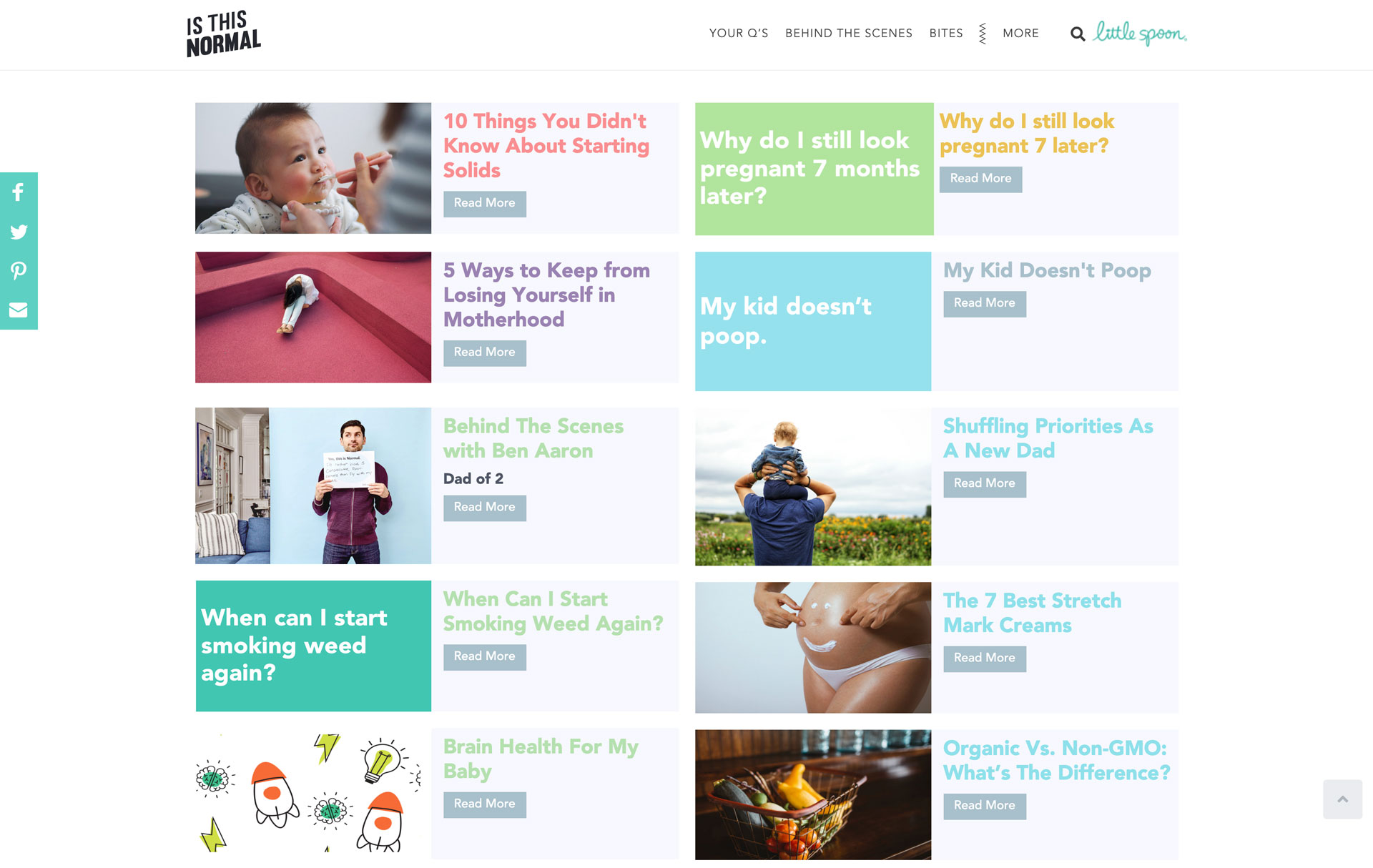With the advances to technology and our access to truly incredible tech in our daily lives, our business’s success is no longer bound by our physical location. We have the ability to reach clients all over the world like never before. And even more so, they are looking for us.
Consider all the ways your clients use technology to engage with your brand; websites, social media, mobile devices, digital marketing, email marketing, podcasts, and beyond. More and more social or lifestyle brands are popping up every day on social media with thriving communities of active participants and raving fans helping propel them towards success.
So how does blogging come into all of this and what does it have to do with you?
Blogging creates an opportunity to align your brand as a thought leader in your industry.
Blogging creates an opportunity to align your brand as a thought leader in your industry, go-to resource for your niche, and community leader on social media. You have the ability to address your audience directly, on your turf (aka your website) surrounded by all your resources, products, services, and contact information, creating opportunities for personal engagement, conversation, and even potential sales just through sharing your expertise.
Why Blogging Is the Best Way to Build Your Brand
Why start a blog? Hmmmm… let me list the reasons, my friends:
- Thought Leadership
- Creditability
- Product/Service Promotion
- Client + Community Education
- Entertainment
- Thought-Provoking + Conversation Sparking
- Community Engagement
- Collaboration
- Networking
- Artistic Outlet
I bet together we could easily think of 1 million more reasons why a blog is an incredible brand asset to any business, but you get where I’m going with this. It gives us a creative space to utilize in any way that most supports our brands.
First, let’s think about our business for a moment:
- What is it we do?
- Who is it we serve?
- Why is this important?
Next up, think about the different products, services, or value you have to offer through your business:
- How do you save your client’s time?
- How do you save your client’s energy?
- How do you save your client’s money?
Are you a teacher, doctor, cook, coach, artist, student, freelancer… {insert your profession here}. No matter who you are, a blog opens up the chance to share your credibility as an expert professional in your industry. It’s a great way to show that not only are you knowledgeable in your trade, but you also know how to teach it and pass on your knowledge to others. It can even serve to help promote you to potential clients in need of your services – even if they didn’t know it when they first found you.
What Should You Blog About
What questions do you repeatedly get from clients that you could answer in an article on your website?
Go back to that little question I asked earlier, “what do you provide?” What specific areas within your industry do you address through your business? Break down the various focuses within your brand.
A great place to start is your inquiry forms, or even better, Google. What questions do you repeatedly get from clients that you could answer in an article on your website? What might people be “Googling” to find you or your services that you could better address and show up for if you wrote a few articles about it?
Try This:
Head over to Google and type in a service or product you offer and add in “how to…” or a variation of a simple question at the start of your search and see what Google auto-fills out for you.
Example: we offer “branding” services, so I typed in “How to” before “Brand” and this is what the top searches auto-filled for me:

Some of the top results were:
- How to brand yourself
- How to brand your business
- How to brand a name
- How to brand yourself on social media
- How to brand your Instagram
So to help our business show up for more than just “branding” or “branding packages” which are highly competitive search terms, we created some posts that directly answered these top “branding” questions that other real humans (and potential clients) have actually been asking and searching for.
Our blog articles:
- How to Brand Yourself
- How to Brand Your Business
- How to Brand A Name
- How to Brand Yourself on Social Media
- How to Brand Your Instagram
How to Brand Your Instagram is our most popular article to date and has continued to be our top traffic driver for years, bringing in over 50% of our traffic. From ONE blog post. We clearly hit a “brand” nerve with that one and it has paid dividends in the form of site traffic, client inquiries, and incredible booked clients.
This doesn’t work for just us, but works for everyone who might be found online by a potential client. Seriously – go try it and see what shows up for you.
Real World Example: Little Spoon
Little Spoon is a baby food delivery company, similar to Freshly or Sun Basket, but with a very specific (and tiny) target client group – babies. They provide fresh organic baby blends scientifically curated to best meet the nutritional and developmental needs of today’s tiniest humans. With more and more families having two working parents, creating balanced and nutritional meals for our kids can be extra hard. Little Spoon is here to make it that much easier. They took our “Google Search” method up a notch with their “Is This Normal” campaign where they answer many of today’s most searched questions about everything parenting – not just baby food. Their blog includes articles like, “10 Things You Didn’t Know About Starting Solids,” “The Basics of Baby Nutrition,” “My Kid Doesn’t Poop,” and “Why Do I Still Look Pregnant 7 Months Later.” They researched what moms and dads are really asking and created a fabulous (and fun) resource to answer any of their most pressing parenting questions. This campaign has translated perfectly to their social media platforms and reached that many more families in need of their services, even if they didn’t know they needed it.

Little Spoon’s “blog” establishes them as leaders in the baby nutrition market and shows that their products aren’t just well-researched meals, but they really understanding what new parents are going through and how to become a parent’s best friend during those first few insane years.
Your Turn
1. Take out a sheet of paper and start listing out all the various areas of expertise you have within your industry. For example, if you are a music teacher what areas of music or teaching are you most knowledgeable in and how could you potentially break those focuses down into segmented blog or article categories?
Ex: Music Teacher: voice, guitar, piano, musicianship, performance, lessons for kids, lessons for adults, audition techniques, college prep, practice tips, reading music, composition… etc.
2. List out as many as you can and then evaluate which ones are similar to others and could be categorized together. Eliminate any duplicate sections and try to come up with at least 3-5 core categories of topics that your blog content could be broken down into.
Ex: Going through our list of music areas we can break down potential categories into:
- Lessons
- Music for Kids
- Music for Adults
- Audition Prep
3. Now, with your 3-5 core categories of topics in hand, brainstorm a number of post topics that could be filed under each of those categories. These could be post titles, examples, portfolio pieces, case studies, DIY, instructional pieces, recipes, anything that directly relates to your business, audience and will support the creditability of your brand.
Ex: Using our music teacher example, a possible list of potential blog posts or topics in the “music for kids” category could be:
- How Old Should a Child be to Start Music Lessons?
- What Instrument is Best for My Child?
- How to Teach Piano to a Child.
Ok, now that you’ve got your list of categories and post topics in hand, it’s time to get down and start creating some solid content. (If only it were that easy, right?) While creating content is important, creating consistent and valuable content is even more important.
How often should you post?
Everyone is different and there is no one blogging system that fits them all. You will learn what’s best for you.
This answer really comes down to you and your available time, as well as your market and service scope. Depending on your business’ size and available time to dedicate towards content marketing, you might not be able to churn out a post every day let alone every week. That’s ok! What’s most important is that what you are putting out there is valuable to your audience. Even if you only publish a post once a quarter, or 3 one quarter and none the next. That’s ok. Consistency is important for any brand, but how important is really defined by your unique business.
When we first launched back in 2014, we spent a year creating post content that we could leverage for our marketing efforts before ever publishing anything. That worked for us because we had the time. Now, we’re lucky if we publish a post once a quarter or even a year. Instead, we’ve focused our energy on creating what’s referred to as “evergreen content” or content that is always relevant – year around and for years. This allows our limited content development energy to be spent on pieces that will last the longest and have the greatest return for our time investment in creating them. Then, instead of constantly creating new content, we just regularly revisit our posts to make sure they are still relevant and valuable, tweaking as necessary. This allows us to keep our articles fresh, and free up time for when those really exciting new article ideas come up.
Other bloggers or writers will cringe when they read that last paragraph, but if we’ve learned anything these past years working with professionals up and down the corporate ladder and across countless industries, everyone is different and there is no one blogging system that fits them all. You will learn what’s best for you.
Above all, make sure you set goals for your blog.
Set Clear and Measurable Blogging Goals
Just like anything else in business, try to avoid the throwing spaghetti on the wall to see what sticks tactic, but instead set some clear and measurable goals for your blog to help track your success and Blogging ROI. What do you want from people who find their way to your blog?
- Goal: To subscribe to your list.
Measurable Tracker: Your list growth. - Goal: To share your work on social media.
Measurable Tracker: Social media following and post engagement. - Goal: To contact you (potential clients).
Measurable Tracker: Contact form submissions and total booked projects.
If you’ve made it this far, we salute you! By taking charge of both only how and where your clients can come in contact and engage with your brand, you’ll open up your business to exponential growth opportunities, increase conversions, and elevate brand loyalty.







